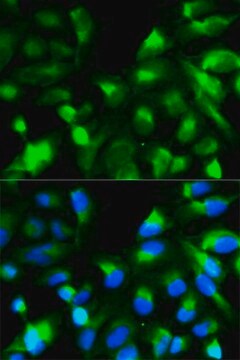Key Documents
S9684
Anti-SNAP-25 antibody produced in rabbit
IgG fraction of antiserum, buffered aqueous solution
About This Item
Polecane produkty
pochodzenie biologiczne
rabbit
Poziom jakości
białko sprzężone
unconjugated
forma przeciwciała
IgG fraction of antiserum
rodzaj przeciwciała
primary antibodies
klon
polyclonal
Postać
buffered aqueous solution
masa cząsteczkowa
antigen 25 kDa
reaktywność gatunkowa
rat, mouse
opakowanie
antibody small pack of 25 μL
metody
immunohistochemistry (formalin-fixed, paraffin-embedded sections): 1:5,000 using rat cerebellum sections
microarray: suitable
western blot: 1:10,000 using rat pheochromocytoma PC12 cell extract
western blot: 1:5,000 using mouse brain extract
numer dostępu UniProt
Warunki transportu
dry ice
temp. przechowywania
−20°C
docelowa modyfikacja potranslacyjna
unmodified
informacje o genach
human ... SNAP25(6616)
mouse ... Snap25(20614)
rat ... Snap25(25012)
Opis ogólny
Anti-SNAP-25 is developed in rabbit using a synthetic peptide corresponding to the N-terminus of human SNAP-25 conjugated to KLH as immunogen. This sequence is identical in SNAP-25 alternatively spliced forms SNAP-25A and SNAP-25B, in mouse, rat and chicken SNAP-25 and highly conserved (80-85%) in goldfish and zebrafish SNAP25. Whole antiserum is fractionated and then further purified by ion-exchange chromatography to provide the IgG fraction of antiserum that is essentially free of other rabbit serum proteins. Anti-SNAP-25 recognizes mouse SNAP-25 (25 kD). The antibody cross-reacts with rat SNAP-25. Applications include the detection and localization of SNAP-25 (25 kDa) by immunoblotting and immunohistochemistry. Staining of SNAP-25 in immunoblotting is specifically inhibited with SNAP-25 immunizing peptide (SNAP-25, mouse)
Specyficzność
Immunogen
Zastosowanie
- the primary detection of SNAP-25
- enzyme-linked immunosorbent assay in human neuroblastoma cell lines
- immunohistochemistry
- in human neuronal cells using western blotting
Działania biochem./fizjol.
The molecular events leading to neurotransmitter release in the synaptic cleft are complex, involving multiple interacting proteins, generically termed SNAP receptors (SNAREs). It has been suggested that SNAP-25 and syntaxin on the neuronal plasma membrane (t-SNARE) and synaptobrevin/VAMP on the synaptic vesicle (v-SNARE) form a stable ternary complex. This core complex serves as a docking complex for two additional membrane fusion proteins, β-SNAP and NSF. ATP hydrolysis by NSF causes dissociation of the complex during priming of the exocytosis machinery. SNAP-25 induced reassembly and interaction with synaptotagmin (Syt), is thought to drive the Ca2+ -triggered vesicle-plasma membrane fusion and exocytosis. SNAP-25 has a key role in both developing and mature neurons. During development, SNAP-25 expression correlates with synaptogenesis, axonal growth and neuronal maturation and is found mainly in cell bodies of neonatal brain. In the adult nervous system, SNAP-25 is localized to presynaptic nerve terminals where it is conveyed by fast axonal transport.
SNAP-25 consists of two alternatively spliced isoforms SNAP-25a and SNAP-25b, differentially expressed in neurons and neuroendocrine cells. SNAP-25a and SNAP-25b differ by nine amino acids in the central domain. Two of these residues alter the relative positioning of clustered cysteine residues that are required for post-translational palmitoylation implicated in membrane anchoring, suggesting that the two SNAP-25 isoforms may play distinct roles in vesicular fusion events.
Postać fizyczna
Przechowywanie i stabilność
Oświadczenie o zrzeczeniu się odpowiedzialności
Nie możesz znaleźć właściwego produktu?
Wypróbuj nasz Narzędzie selektora produktów.
Kod klasy składowania
12 - Non Combustible Liquids
Klasa zagrożenia wodnego (WGK)
nwg
Temperatura zapłonu (°F)
Not applicable
Temperatura zapłonu (°C)
Not applicable
Środki ochrony indywidualnej
Eyeshields, Gloves, multi-purpose combination respirator cartridge (US)
Certyfikaty analizy (CoA)
Poszukaj Certyfikaty analizy (CoA), wpisując numer partii/serii produktów. Numery serii i partii można znaleźć na etykiecie produktu po słowach „seria” lub „partia”.
Masz już ten produkt?
Dokumenty związane z niedawno zakupionymi produktami zostały zamieszczone w Bibliotece dokumentów.
Klienci oglądali również te produkty
Nasz zespół naukowców ma doświadczenie we wszystkich obszarach badań, w tym w naukach przyrodniczych, materiałoznawstwie, syntezie chemicznej, chromatografii, analityce i wielu innych dziedzinach.
Skontaktuj się z zespołem ds. pomocy technicznej














